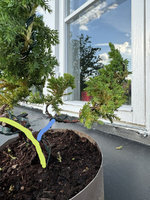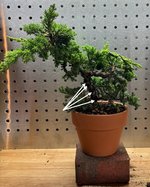I think this is some good material with branches well placed to makes something good in the future.
I've got some thoughts for you to consider which I think follow along with your initial shaping.
View attachment 549879
Is it possible for you to put some shape into the first section of the trunk coming out of the pot?
It looks better if you avoid a trunk with a straight line as in the picture below:
View attachment 549880
Junipers give an excellent opportunity to add interesting twists and bends as they are so flexible. With cascade, the trunk has to arc up and over the edge of the pot, but it will also improve the design if you can have some movement in that first section of the trunk between the soil line and the vertical branch. It doesn't need to be too dramatic, but as you go forward and you expose the trunk, develop the roots and the base starts to thicken, you will want to show that section off. Not sure how difficult it is or how much flexibility you have available? Maybe needs to be done with thick wire and rebar.
Also, in the first pic I provided, the light blue section, if you decide not to jin it, I suggest putting more back and forwards movement in that section with wire.
My personal preference would be to use that light blue section as the back portion of then tree. I would use the vertical branch for the top and bring it down, compacting it closer to the base. Then I would work on thickening those two sections and then build in taper. While developing the tree, I am sure you will get plenty of opportunity to add a jin if you don't use the current back branch for that purpose.
Here is a rough example of my suggestions above with a roughly placed triangle to guide the overall shape.
If you do wire out the cascading trunk more, consider where future pads will be, you want to aim to have branches from the trunk on the outsides of curves and bends and remove those that are on the inside.
View attachment 549881
It is also worth considering at some point in the main trunkline to cut the end off and regrow to improve the taper, again going back to my first suggestion of avoiding the trunk be a single line. It may take a year or two to regrow the length, but the taper it provides will be a big improvement.

















